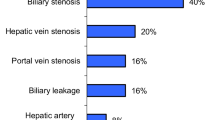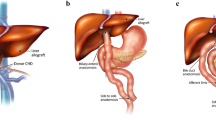Abstract
Postoperative biliary and vascular complications contribute significantly to morbidity and mortality in liver transplantation. Interventional radiologists are an integral part of the multidisciplinary team necessary for optimizing the management of these complications. During a 15-year period, 39 cadaveric and 25 living related liver transplantations were performed at the Chang Gung Memorial hospital, Taiwan. Of 64 liver transplant recipients, 9 (3 adult and 6 pediatric) underwent 13 interventional radiological procedures for the treatment of biliary sludge-casts (n = 2), bile duct occlusion or stenosis (n = 2), hepatic veins thrombosis (n = 1), hepatic veins stenosis (n = 1), portal vein stenosis with splenorenal shunting (n = 1), biloma (n = 1), and infected fluid collection or ascites (n = 4). Antegrade or retrograde interventional approach was used to successfully treat all biliary complications, and all percutaneous drainage procedures were effective in the control of intra-abdominal fluid collections. Portal vein stenosis was treated by balloon dilatation, and the associated splenorenal shunt was closed by metallic coil embolization via transhepatic catheterization of the portal vein. Hepatic vein stenosis was effectively treated by balloon dilatation and expandable metallic stent deployment via transfemoral and jugular venous approaches, respectively. Hepatic vein thrombosis was only partially lysed by transvenous streptokinase administration, and surgical thrombectomy was needed to achieve complete recanalization. The total success rate of the interventional procedures was 92 % with no procedure-related complications. The overall survival rate in this series is 89 %, and all patients who underwent living related liver transplantation maintain to date a 100 % survival rate. We can conclude that interventional radiological procedures are very useful for managing biliary and vascular complications after liver transplantation. These techniques provide a cure in most situations, thus obviating the need for further surgical intervention or re-transplantation.
Similar content being viewed by others
Author information
Authors and Affiliations
Additional information
Received: 6 March 2000 Accepted: 5 May 2001
About this article
Cite this article
Cheng, Y., Chen, Y., Huang, T. et al. Interventional radiologic procedures in liver transplantation. Transpl Int 14, 223–229 (2001). https://doi.org/10.1007/s001470100324
Published:
Issue Date:
DOI: https://doi.org/10.1007/s001470100324




